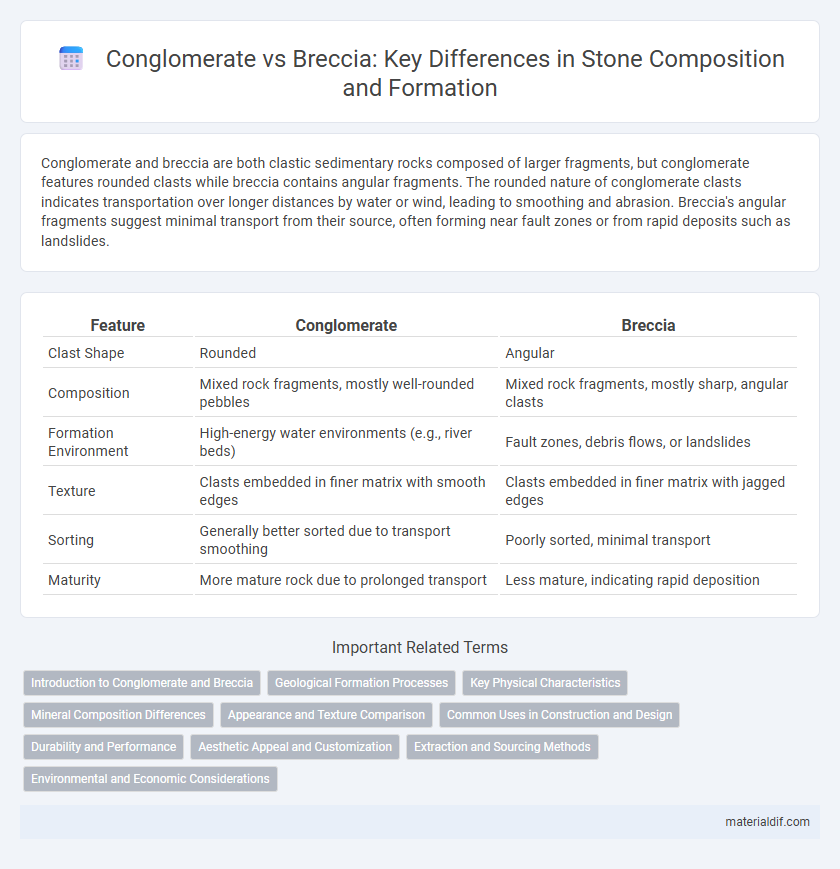Conglomerate and breccia are both clastic sedimentary rocks composed of larger fragments, but conglomerate features rounded clasts while breccia contains angular fragments. The rounded nature of conglomerate clasts indicates transportation over longer distances by water or wind, leading to smoothing and abrasion. Breccia's angular fragments suggest minimal transport from their source, often forming near fault zones or from rapid deposits such as landslides.
Table of Comparison
| Feature | Conglomerate | Breccia |
|---|---|---|
| Clast Shape | Rounded | Angular |
| Composition | Mixed rock fragments, mostly well-rounded pebbles | Mixed rock fragments, mostly sharp, angular clasts |
| Formation Environment | High-energy water environments (e.g., river beds) | Fault zones, debris flows, or landslides |
| Texture | Clasts embedded in finer matrix with smooth edges | Clasts embedded in finer matrix with jagged edges |
| Sorting | Generally better sorted due to transport smoothing | Poorly sorted, minimal transport |
| Maturity | More mature rock due to prolonged transport | Less mature, indicating rapid deposition |
Introduction to Conglomerate and Breccia
Conglomerate is a coarse-grained sedimentary rock composed predominantly of rounded clasts cemented by finer material, formed through the deposition of water-worn fragments. Breccia differs by its angular clasts, indicating minimal transport before lithification, often associated with tectonic or volcanic activity. Both rocks provide insights into sedimentary processes and the geological history of their depositional environments.
Geological Formation Processes
Conglomerate forms from the cementation of rounded rock fragments typically transported and smoothed by water, indicating a high-energy environment like riverbeds or beaches. Breccia consists of angular, sharply fractured rock fragments deposited close to their source, often resulting from tectonic activity, landslides, or volcanic eruptions. These differences in particle shape and deposition reveal contrasting geological processes, with conglomerate pointing to prolonged transport and breccia to short-distance, rapid deposition.
Key Physical Characteristics
Conglomerate features rounded clasts that have been smoothed by transportation, while breccia contains angular, jagged fragments indicating minimal movement from their source. Both rocks consist of coarse-grained clasts, but conglomerate typically exhibits well-sorted, tightly packed pebbles compared to the poorly sorted, loosely cemented nature of breccia. These key physical characteristics influence their porosity, permeability, and suitability for various construction and geological applications.
Mineral Composition Differences
Conglomerate consists mainly of rounded clasts composed of quartz, chert, and feldspar minerals, indicating prolonged water transport and weathering. Breccia features angular fragments predominantly of volcanic, sedimentary, or metamorphic minerals, reflecting minimal transport and rapid deposition. The mineral composition differences highlight distinct geological processes, with conglomerates undergoing more abrasion and breccias preserving fresher rock fragments.
Appearance and Texture Comparison
Conglomerate features rounded clasts that create a smooth, pebbly texture, whereas breccia consists of angular, jagged fragments producing a rougher, more fragmented appearance. The rounded shapes in conglomerates indicate transportation over long distances, contributing to their polished surface, while breccias reflect minimal transport with their sharp, interlocking rock pieces. Texture differences between these sedimentary rocks are key for distinguishing their depositional environments and geological history.
Common Uses in Construction and Design
Conglomerate is widely used in construction for decorative aggregates, concrete, and landscaping due to its rounded clasts, which provide a smoother texture and enhanced durability. Breccia, characterized by its angular fragments, is favored in architectural design and interior applications where a striking, rugged appearance is desired, such as in cladding, countertops, and ornamental stonework. Both stones offer unique aesthetic and structural properties, with conglomerate excelling in outdoor environments and breccia preferred for bold statement pieces indoors.
Durability and Performance
Conglomerate exhibits greater durability than breccia due to its well-rounded clasts that interlock tightly, enhancing resistance to weathering and mechanical stress. Breccia's angular fragments create more points of weakness, making it less suitable for high-performance construction applications where strength and longevity are critical. In infrastructure projects, conglomerate's superior compression strength and erosion resistance result in better long-term performance compared to breccia.
Aesthetic Appeal and Customization
Conglomerate features smooth, rounded clasts that create a polished, harmonious aesthetic ideal for modern and minimalist designs, while breccia displays angular, irregular fragments offering a bold, textured appearance suited to rustic or industrial styles. Customization options in conglomerate often emphasize color blending and surface finishing to enhance its natural fluidity, whereas breccia customization focuses on highlighting sharp contrasts and unique patterns by selecting varied clast sizes and matrix compositions. Both stones provide versatile aesthetic appeal, allowing designers to tailor surfaces for specific visual impacts in architectural and interior applications.
Extraction and Sourcing Methods
Conglomerate extraction involves quarrying from sedimentary deposits where rounded gravel and pebbles are cemented by siliceous or calcareous material, often requiring heavy machinery to separate the cohesive fragments without damaging the smooth clasts. Breccia sourcing targets angular, fractured rock typically found in tectonically active zones or fault breccias, necessitating careful blasting and controlled mining techniques to preserve the sharp edges and matrix integrity. Both stones demand tailored processing methods due to their distinct clast shapes and bonding agents, impacting their respective extraction costs and material quality for construction or decorative use.
Environmental and Economic Considerations
Conglomerate and breccia differ significantly in environmental and economic impacts due to their formation and composition; conglomerates, with rounded clasts, often indicate well-sorted sedimentary environments that support stable ecosystems and enable efficient quarrying. Breccia, characterized by angular fragments, forms in more tectonically active or high-energy environments, sometimes associated with increased environmental disturbance but offering valuable localized mineral deposits. Economically, conglomerates provide more uniform building materials, while breccias can be sources of precious metals or industrial minerals, influencing extraction costs and land rehabilitation efforts.
Conglomerate vs Breccia Infographic

 materialdif.com
materialdif.com